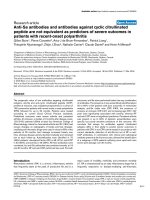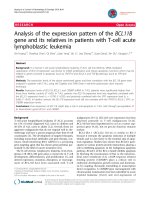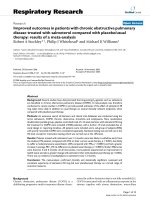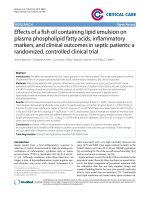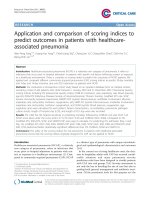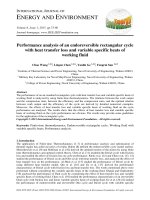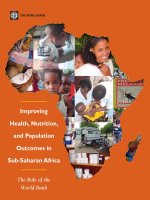ANALYSIS OF RETINAL FLUID AND VISION OUTCOMES IN THE ARCHWAY PHASE 3 TRIAL OF THE PORT DELIVERY SYSTEM WITH RANIBIZUMAB (PDS) IN PATIENTS WITH NAMD PRESENTED AT EURETINA 2021
Bạn đang xem bản rút gọn của tài liệu. Xem và tải ngay bản đầy đủ của tài liệu tại đây (355.71 KB, 10 trang )
<span class="text_page_counter">Trang 1</span><div class="page_container" data-page="1">
Analysis of Retinal Fluid and Vision
Outcomes in the Archway Phase 3 Trial of the Port Delivery System With Ranibizumab (PDS) in Patients With nAMD
<b>Presented at EURETINA 2021</b>
<small>1Sierra Eye Institute, Reno, NV; 2 Genentech, Inc., South San Francisco, CA; 3F. Hoffmann-La Roche Ltd., Basel, Switzerland </small>
</div><span class="text_page_counter">Trang 2</span><div class="page_container" data-page="2"><small></small>
<b>Financial Disclosures</b>
Gemini, Genentech, Inc., Graybug, Gyroscope, Iveric Bio, Kato, Kodiak, Novartis, Opthea, Oxurion, PolyPhotonix, Recens Medical, Regenxbio; Research Support: Adverum, Alkahest, Allegro, Allergan, Annexon, Gemini, Genentech, Inc.,
Gyroscope, Iveric Bio, Kodiak, NGM Pharmaceuticals, Novartis, Opthea, Ophthotech, Oxurion, Recens Medical, Regenxbio; Speaker: Allergan, Genentech, Inc., Novartis
Its efficacy and safety profile have not been established and it has not been approved by the health authorities
which was provided by Dionne Turnbull, PhD, of Envision Pharma Group
Disclosures
<b><small>2</small></b>
</div><span class="text_page_counter">Trang 3</span><div class="page_container" data-page="3">The Port Delivery System With Ranibizumab (PDS)
Continuous Intravitreal Delivery of a Customised Formulation of Ranibizumab
2 refill-exchange intervals at weeks 44/48
ranibizumab through week 72
each refill-exchange procedure
are continually being analysed to optimise patient outcomes
<b>Patients with nAMD responsive to </b>
Weeks 36 and 40: primary endpoint
Week 96: final visit
<small>anAMD in study eye diagnosed within 9 months of screening; ≥ 3 intravitreal injections of any anti-VEGF agent within previous 6 months. bEfficacy- and safety-evaluable population. 418 total patients were enrolled, with 251 and 167 patients randomised to the PDS 100 mg/mL Q24W and intravitreal ranibizumab 0.5 mg Q4W arms, respectively; 3 patients in the PDS arm did not receive study treatment and were excluded from the efficacy- and safety-evaluable population. cSupplemental intravitreal ranibizumab 0.5 mg injections were available at the 2 visits preceding each refill-exchange procedure if the following protocol-specified disease activity criteria were met:decrease of ≥ 15 letters from the best-recorded BCVA in the study </small>
<small>OR increase of ≥ 150 µm in CST on SD-OCT from the lowest CST measurement in the study OR increase of ≥ 100 µm in CST on SD-OCT from the lowest CST measurement in the study associated with a decrease of ≥ 10 letters from the best-recorded BCVA during the study. dEquivalence not assessed at weeks 44 and 48 per protocol. Archway, NCT03677934. </small> <b><small>3</small></b>
</div><span class="text_page_counter">Trang 4</span><div class="page_container" data-page="4">
SD-OCT images from the Archway trial were subject to dual-read grading, with the entire macula reviewed for SRF and IRF, graded YES/NO
If graded YES for SRF/IRF, images were further reviewed for SRF/IRF at the centre 1 mm SD-OCT Images From Archway Were Graded for SRF/IRF
<small>Example images of SRF and IRF in participants from the HARBOR study.</small>
<small>ETDRS, Early Treatment Diabetic Retinopathy Study; IRF, intraretinal fluid; SD-OCT, spectral-domain optical coherence tomography; SRF, subretinal fluid.</small>
<b><small>ETDRS Grid</small></b>
<b><small>4</small></b>
</div><span class="text_page_counter">Trang 5</span><div class="page_container" data-page="5">Percentage of Study Eyes With SRF and/or IRF Was Similar Between Treatment Arms and Over Time
<small>IRF, intraretinal fluid; PDS, Port Delivery System with ranibizumab; Q4W, every 4 weeks; Q24W, every 24 weeks; SRF, subretinal fluid.</small>
</div><span class="text_page_counter">Trang 6</span><div class="page_container" data-page="6"><small>BCVA, best-corrected visual acuity; ETDRS, Early Treatment Diabetic Retinopathy Study; IRF, intraretinal fluid; PDS, Port Delivery System with ranibizumab; Q4W, every 4 weeks; Q24W, every 24 weeks; SRF, subretinal fluid.</small>
Vision Outcomes Were Similar Between Treatment Arms Both With and Without SRF and/or IRF
<small>PDS 100 mg/mL Q24W no fluidIntravitreal ranibizumab 0.5 mg Q4W no fluidPDS 100 mg/mL Q24W fluidIntravitreal ranibizumab 0.5 mg Q4W fluid</small>
<b><small>Treatment Arm/Fluid Status at Week 40</small></b>
<b><small>Mean Observed BCVA at Baseline </small></b>
<small>Intravitreal ranibizumab 0.5 mg Q4W no fluid (n = 81)75.7 (20/32)76.4 (20/32)Intravitreal ranibizumab 0.5 mg Q4W fluid (n = 77)75.3 (20/32)75.9 (20/32)</small>
</div><span class="text_page_counter">Trang 7</span><div class="page_container" data-page="7"><small>IRF, intraretinal fluid; PDS, Port Delivery System with ranibizumab; Q4W, every 4 weeks; Q24W, every 24 weeks; SRF, subretinal fluid.</small>
Fluid Dynamics in the Centre 1 mm Were Similar Between Treatment Arms
Relatively Few Patients Had Fluid Presence in the Centre 1 mm
</div><span class="text_page_counter">Trang 8</span><div class="page_container" data-page="8"><small>PDS 100 mg/mL Q24W no fluidIntravitreal ranibizumab 0.5 mg Q4W no fluidPDS 100 mg/mL Q24W fluidIntravitreal ranibizumab 0.5 mg Q4W fluid</small>
<small>BCVA, best-corrected visual acuity; ETDRS, Early Treatment Diabetic Retinopathy Study; PDS, Port Delivery System with ranibizumab; Q4W, every 4 weeks; Q24W, every 24 weeks;SRF, subretinal fluid.</small>
Vision Outcomes Were Similar Between Treatment Arms Both With and Without SRF in the Centre 1 mm
<b><small>Treatment Arm/Fluid Status at Week 40</small></b>
<b><small>Mean Observed BCVA at Baseline</small></b>
<small>Intravitreal ranibizumab 0.5 mg Q4W no fluid (n = 137)75.4 (20/32)76.0 (20/32)Intravitreal ranibizumab 0.5 mg Q4W fluid (n = 21)76.1 (20/32)77.1 (20/32)</small>
</div><span class="text_page_counter">Trang 9</span><div class="page_container" data-page="9"><b><small>Treatment Arm/Fluid Status at Week 40</small></b>
<b><small>Mean Observed BCVA at Baseline </small></b>
<small>Intravitreal ranibizumab 0.5 mg Q4W no fluid (n = 147)75.7 (20/32)76.7 (20/32)Intravitreal ranibizumab 0.5 mg Q4W fluid (n = 11)72.5 (20/40)69.0 (20/40)</small>
<small>PDS 100 mg/mL Q24W no fluidIntravitreal ranibizumab 0.5 mg Q4W no fluidPDS 100 mg/mL Q24W fluidIntravitreal ranibizumab 0.5 mg Q4W fluid</small>
<small>BCVA, best-corrected visual acuity; ETDRS, Early Treatment Diabetic Retinopathy Study; IRF, intraretinal fluid; PDS, Port Delivery System with ranibizumab; Q4W, every 4 weeks;</small>
<b><small>Treatment Arm/Fluid Status at Week 40</small></b>
<b><small>Mean Observed BCVA at Baseline </small></b>
<small>Intravitreal ranibizumab 0.5 mg Q4W no fluid (n = 147)75.7 (20/32)76.7 (20/32)</small>
<b><small>Intravitreal ranibizumab 0.5 mg Q4W fluid (n = 11)</small></b> <small>72.5 (20/40)69.0 (20/40)</small>
<b><small>9</small></b>
</div><span class="text_page_counter">Trang 10</span><div class="page_container" data-page="10">
In Archway, incidence of retinal fluid (SRF and/or IRF) was generally similar in the PDS Q24W and monthly ranibizumab treatment arms and remained consistent over time
Vision outcomes on study were comparable, regardless of the overall presence or absence of SRF and/or IRF in either treatment arm
The presence of IRF in the centre 1 mm was associated with worse vision outcomes, consistent with other trials
Continuous delivery of ranibizumab with PDS Q24W maintained vision outcomes, regardless of the overall presence or absence of retinal fluid
<small>IRF, intraretinal fluid; PDS, Port Delivery System with ranibizumab; Q24W, every 24 weeks; SRF, subretinal fluid.</small> <b><small>10</small></b>
</div>